Please click here to access the main AHDB website and other sectors.
- Home
- Knowledge library
- Spider mites
Spider mites
How to identify a number of spider mite pest species and their symptoms on host plants and gain an appreciation of pest biology to aid in the development of effective control strategies. This section includes details of the key spider mite pest, two-spotted spider mite, and other spider mites, including: bryobia mites, carmine spider mite, citrus red mite, conifer spinning mite, fruit tree red spider mite and Lewis mite.
Back to: The biology and control of mites in ornamentals
Two-spotted spider mite (Tetranychus urticae)
Identification and symptoms
The most common species of spider mite found on ornamentals in the UK is the two-spotted spider mite (Tetranychus urticae). Two-spotted spider mite is a widespread pest of protected crops, as the warmer conditions enable spider mite development and spread to be very rapid. Two-spotted spider mite can also damage nursery stock grown outdoors, particularly when summer temperatures are high.
Two-spotted spider mites are small (0.5 mm) and found on the underside of leaves. Eggs are round and translucent. Young mites (nymphs) and summer adults are green with two black patches on their backs. In the autumn, the females turn brick-red prior to overwintering. Spider mites feed by rasping the lower leaf surface with their mouth parts. Plant sap is then sucked out, leading to small white or pale yellow spots all over the leaf, but it can also take the form of yellow patches or chlorosis. Outbreaks often occur in hot spots, reflecting the site of initial infestation, spreading outwards from this point.
Summer form of two-spotted spider mite, overwintering form (entering diapause) and eggs
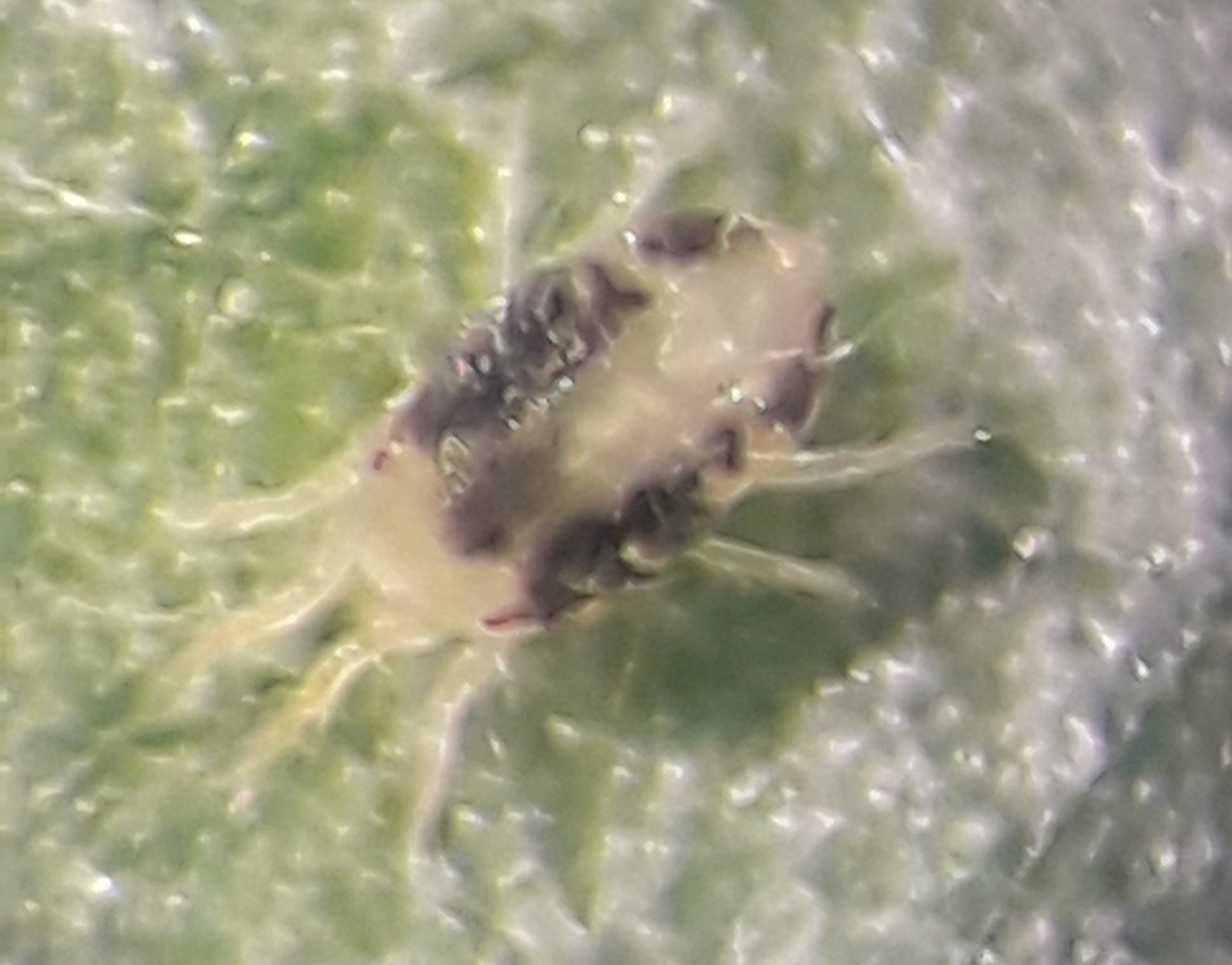
Image © ADAS Horticulture.

Image © ADAS Horticulture.
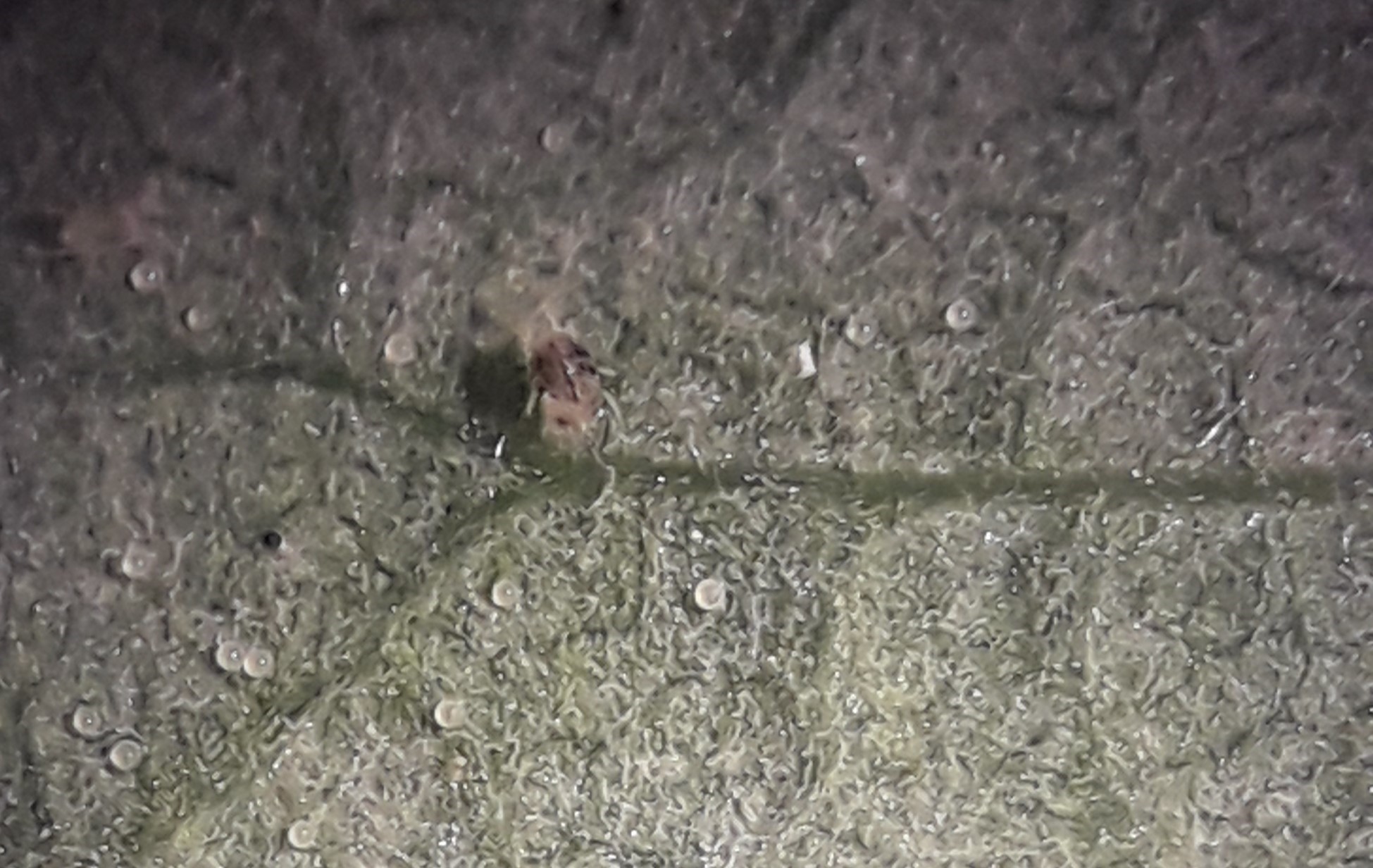
Image © ADAS Horticulture.
Feeding damage can be confused with the damage caused by leafhopper or thrips. Typically, the individual, irregular white spots due to leafhopper damage are much larger than those associated with spider mite damage and cast skins are usually visible. Thrips damage can be distinguished by the presence of small black faecal spots on the white damaged areas.
Two-spotted spider mite feeding on impatiens leaf
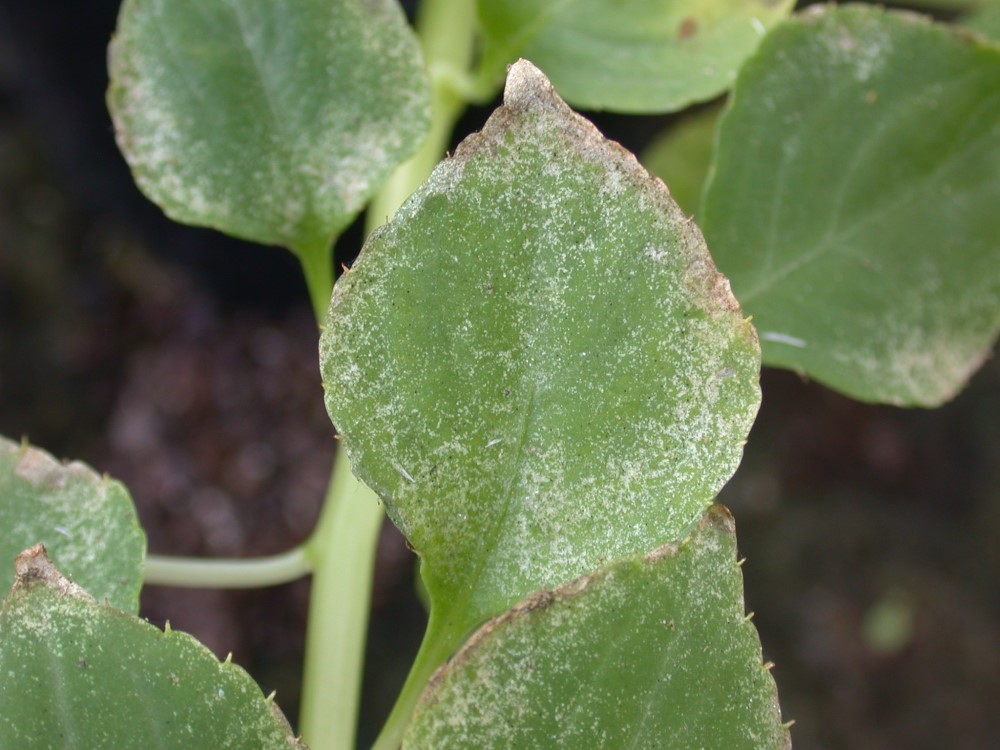
Image © ADAS Horticulture.
On a few plant species, the feeding of two-spotted spider mite causes an extreme reaction, leading to complete leaf yellowing in a short space of time and, if left untreated, plant death. The best example of this phenomenon is on Crinodendron.
When populations build, large numbers of mites gather on the end of shoots and are visible as pale brown balls. The associated webbing is sticky, allowing mites to be spread by staff brushing infested plants. Mites may also be spread on silk threads from adjacent plants or from outdoor host plants, on air currents entering glasshouses or polythene tunnels.
Biology
The two-spotted spider mite is active between spring and autumn but hibernates in a state of diapause (a period of suspended development) over the winter.
Winter
Mites overwinter as hibernating females which are orange/red in colour. They hide under the rims of pots, in splits in canes, underneath pots and trays, on plant debris, or within the glasshouse structure and irrigation pipes. During this time, they do not feed or lay eggs and cannot be controlled by plant protection products.
Spring
When temperatures and day lengths increase in spring, the hibernating females become active and lay eggs, after which they die. The females prefer to lay eggs on the lower leaf surface of host plants.
The eggs hatch into larvae, then moult to become nymphs and finally develop into summer adults. Both males and females are produced, with the female being larger and less active than the male. All active stages feed on the lower leaf surface. Silken thread or webbing is often copiously produced by the mites and can easily be seen with a handheld lens or with the naked eye, if severe.
Summer
Breeding continues throughout the summer, with the speed at which the mites develop being directly related to temperature. In cool conditions (~15ºC), the life cycle from egg to adult takes about 35 days to complete, while at higher temperatures, it can be completed in as little as five days. In warm summers, therefore, spider mite development and population build-up can be extremely rapid. The optimum conditions are 29–35°C and 20–40% relative humidity, but the mites can reproduce at temperatures between 12°C and 40ºC. Low humidity contributes to an increase in spider mite numbers. However, even in areas where relative humidity is high, such as propagation houses, spider mites can still reproduce and cause damage.
Autumn
When day lengths shorten in the autumn and temperatures drop, the adult females start to hibernate, by entering diapause. Diapause may also be stimulated by dense populations in the summer on senescing plants, making their food source scarce. If conditions remain favourable, such as under supplementary lighting and in heated glasshouses, mites will continue to lay eggs all winter.
Host plants
Two-spotted spider mite has been recorded on over 150 species of economically important plants and affects at least 900 species worldwide.
This pest has a number of ornamental host plants. Table 1 lists some of the most common bedding plant, pot plant and hardy nursery stock species affected.
Table 1. Host plants of two-spotted spider mite
|
Bedding and pot plants |
Herbaceous and hardy nursery stock |
|
|
Amaryllis |
Acer |
Liriope |
|
Antirrhinum |
Althaea |
Lonicera |
|
Callistephus |
Aralia |
Malus |
|
Celosia |
Aucuba |
Meconopsis |
|
Chrysanthemum |
Buddleia |
Pachysandra |
|
Cosmos |
Calluna |
Penstemon |
|
Dahlia |
Catalpa |
Phlox |
|
Fuchsia |
Ceanothus |
Phormium |
|
Hedera |
Choisya |
Pieris |
|
Impatiens |
Clematis |
Potentilla |
|
Lathyrus |
Cordyline |
Prunus |
|
Poinsettia |
Crataegus |
Pyrus |
|
Primula |
Crinodendron |
Rosa |
|
Ricinus |
Delphinium |
Sambucus |
|
Rosa |
Digitalis |
Skimmia |
|
Salvia |
Euonymus |
Sorbus |
|
Viola |
Euphorbia |
Spirea |
|
Zinnia |
Exochorda |
Trachleospermum |
|
|
Geum |
Tropaeolum |
|
|
Hellebore |
Tsuga |
|
|
Hydrangea |
Verbascum |
|
|
Ilex |
Viburnum |
|
|
Laburnum |
Weigelia |
|
|
Lavatera |
Wisteria |
The type of host plant does not significantly affect the duration of the life cycle, but it can dramatically affect population build-up. On susceptible plants, such as Choisya, the number of summer eggs laid by the female mites will rise substantially compared with other plants. For example, trials have shown that the mean total number of eggs produced by each female increases from 12 on Ceanothus to around 86 on Choisya.
Population increases lead to webbing and the accumulation of mites at leaf tips
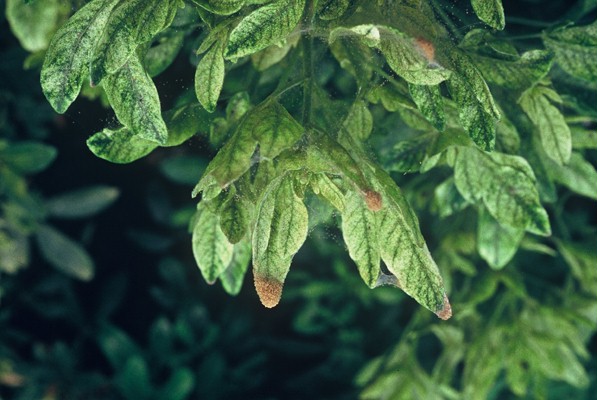
Image © ADAS Horticulture.
Bryobia mites (Bryobia cristata, B. kissophila, B. praetiosa and B. rubrioculus)
Identification and symptoms
There are a number of species of bryobia mites that impact ornamental crops, but they are of less commercial significance compared with the two-spotted spider mite. The mites are dark reddish brown, 0.6–0.7 mm in length and are found mainly on the upper leaf surface. The adults have a very long pair of front legs, which are usually held outstretched in front of the body. Eggs and nymphal stages are also dark orange/red.
Feeding causes silvering on the upper leaf surface and this can be confused with damage caused by thrips or two-spotted spider mites. Unlike two-spotted spider mite, bryobia mites do not produce webbing. Species that can damage ornamentals include Bryobia cristata, (grass-pear bryobia mite), B. kissophila (ivy bryobia mite), B. praetiosa (clover bryobia mite) and B. rubrioculus (apple and pear bryobia mite).
Biology
Depending on species, during the summer, the mites can breed continuously under glasshouse conditions and the life cycle takes about four weeks from egg to adult, so five to six generations can be completed each year. Some species overwinter in the glasshouse or polythene tunnel structure, while others hibernate in sheltered locations outdoors. In spring, activity resumes and large numbers of mites can enter glasshouses or tunnels.
Host plants
Bryobia cristata can infest various ornamentals, including: Campanula, Cyclamen, Dianthus, Gentiana, Iris, Polyanthus and Saxifraga; B. kissophila is a pest of both wild and ornamental ivies; B. praetiosa can occur in large numbers on sunny walls of buildings in the spring and infest grasses and herbaceous plants during the summer; and B. rubrioculus affects Malus, Prunus and Pyrus.
Adult bryobia mite with distinctive long front legs
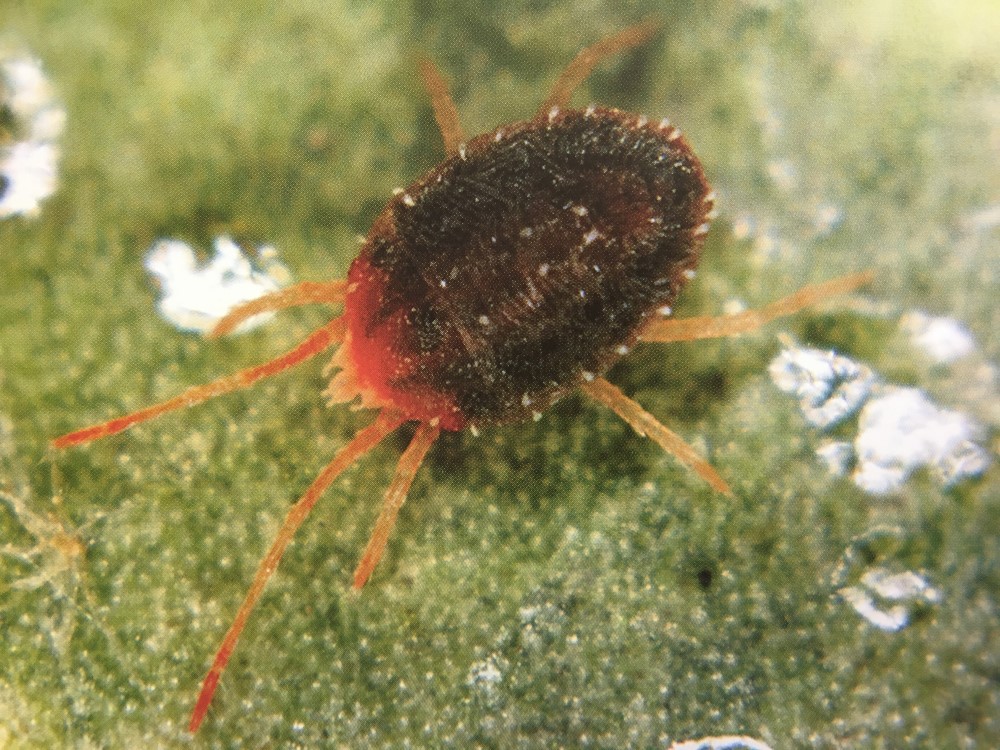
Image © ADAS Horticulture.
Carmine spider mite (Tetranychus cinnabarinus)
Identification and symptoms
This subtropical species looks similar to the two-spotted spider mite, but adult females are dark red and the eggs are whitish to pink rather than translucent. Like the two-spotted spider mite, the species also produces webbing. Infested leaves become discoloured and those of carnation and Dianthus tend to curl downwards.
Biology
Carmine spider mites tend to stay on their host plant and, unlike the two-spotted spider mite, do not go into diapause over winter. Warm periods in the glasshouse in winter can stimulate feeding and egg production. The optimum temperature for development is 32°C, but the mites can reproduce at temperatures well above 35°C.
Host plants
Carmine spider mite is more commonly a pest of protected tomato but can also infest protected carnation, Chrysanthemum, citrus, Cymbidium, Dianthus, Gladioli, Tagetes and Rosa.
Adult carmine spider mite on leaf surface
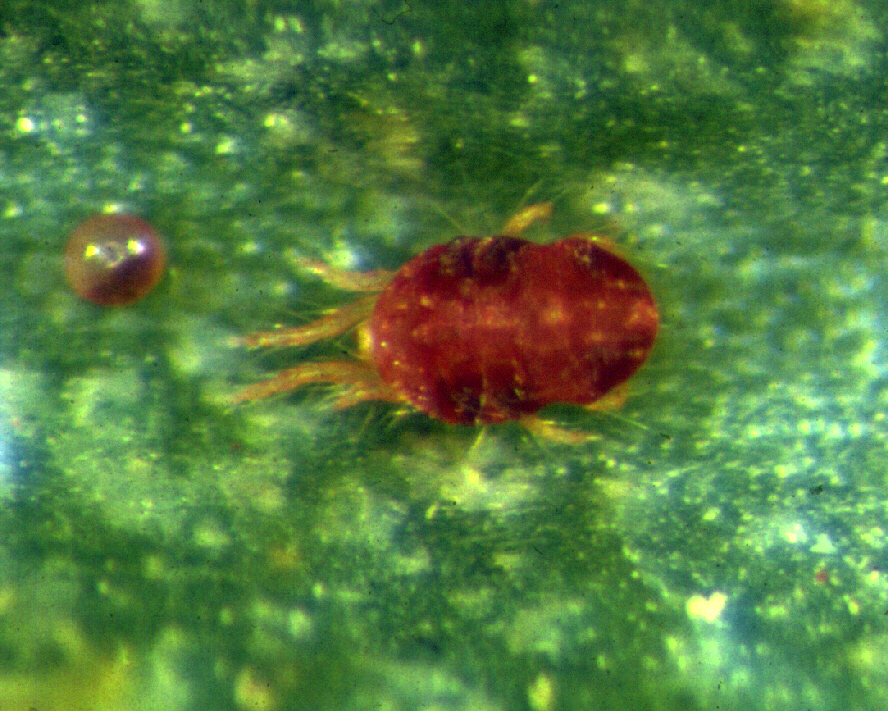
Image © ADAS Horticulture.
Citrus red mite (Panonychus citri)
Identification and symptoms
The citrus red mite (Panonychus citri) appears to be increasing in importance in the UK. It can be identified by its brownish red colour when mature and the presence of long white or pink hairs or setae. However, unlike the fruit tree red spider mite, these hairs do not have white spots at their base. The eggs are red, almost spherical and slightly flattened, with a crooked hair or ‘stipe’ sticking out from the top.
Feeding damage produces stippling, with light-coloured or silvery spots on leaves, similar to the damage caused by fruit tree red spider mite. Heavy mite infestation combined with low humidity, wind or drought stress can lead to leaf drop and dieback.
Biology
The pest population increases most rapidly in line with new growth in spring. The mite completes its life cycle in 14 days at 21ºC but develops nine times slower at 10ºC. However, at high temperatures, the mites have a shortened lifespan compared with lower temperatures.
Host plants
In addition to Citrus species, ornamental host plants include: Choisya, Elaeagnus, Ilex, Prunus, Pyrus, Rosa and Skimmia.
Conifer spinning mite (Oligonychus ununguis)
Identification, symptoms, biology and host plants
Adults are small, dark green, orange to brownish or blackish. Nymphs are more greenish in colour and eggs are spherical, greenish brown to orange-red. Mites remain on the host plant and can generate considerable quantities of webbing. Infested needles become discoloured, eventually turning brown and falling prematurely. Heavy infestations impact plant vigour. The conifer spinning mite is a common pest of conifers, especially Picea.
Fruit tree red spider mite (Panonychus ulmi)
Identification and symptoms
The fruit tree red spider mite (Panonychus ulmi), known in other countries as the European red mite, occurs mainly on outdoor crops. This species can be identified by its brownish red colour and the long white hairs (setae) visible on the upper body which arise from white bumps on the body (tubercules). The white tubercles at the base of the hairs distinguish this species from the citrus red mite. Immature mites feed on the leaf underside, but adults may feed on either side when population densities are high. Eggs are globular and slightly flattened, with many fine grooves running from the base to the top and with a long hair or ‘stipe’ sticking out of the top, giving them a shape like an onion. Summer eggs vary in colour, from pale green, dark green, reddish brown, dark orange and bright red, whereas winter eggs are dark red.
Feeding damage becomes pale and bronzed. Heavy infestations can turn leaves brown and cause them to drop.
Biology
The fruit tree red spider mite survives winter as eggs, placed in groups on bark close to where new growth will form. Overwintering eggs can be laid between August and November and generally hatch when the first blossom buds start to colour. Typically, eggs do not start to develop until temperatures exceed 7ºC. The life cycle is completed in three to four weeks and there are about five overlapping generations during the summer. Summer eggs are laid from May onwards. Mite numbers tend to drop from September onwards as winter eggs are laid.
Host plants
The mite is an important pest of apple and other fruit crops but can also be found on: Castanea, Chaenomeles, Cotoneaster, Crataegus, Juglans, Rosa, Sorbus and Ulmus.
Lewis mite (Eotetranychus lewisi)
Identification, symptoms, biology and host plants
The Lewis spider mite (Eotetranychus lewisi) looks very similar to the two-spotted spider mite but is slightly smaller and adult females have several small spots on the body, rather than two large spots, one on each side of the body. However, the species can only be confirmed by specialist laboratory examination. Damage symptoms are similar to those of the two-spotted spider mite – they cause leaf stippling and a speckled yellowing effect on the underside of leaves. Severe infestations can cause leaves to drop. The mite does not go into diapause over winter and has only been confirmed once in the UK, on poinsettia in 2014, when it was eradicated. Lewis spider mite is a notifiable quarantine pest in Great Britain. Other ornamental host plants include: Abutilon, Ceanothus, Cleome, Euphorbia, Hydrangea and Monarda.
Useful links
Further information on the two-spotted spider mite and fruit tree red spider mite can be found in the AHDB guide ‘Managing spider mites in cherry’.
Managing spider mites in cherry
Details about the Lewis mite can be found in the Defra Plant Pest Factsheet ‘Pest and Disease Threats to Herbaceous and Ornamental Crops’.
Defra factsheet: Pest and Disease Threats to Herbaceous and Ornamental Crops
Authors
Authors – Elysia Bartel and Jude Bennison, ADAS Horticulture.
Original author (08/05 ‘The biology and control of two-spotted spider mite in nursery stock’ and 12/09 ‘The biology and control of mites in pot and bedding plants’) – John Buxton, ADAS.
Got a question? Ask a member of the team:
Web page content correct as of June 2021.
The fruit tree red spider mite is brownish red in colour, has long white dorsal hairs, arising from white bumps on the body (tubercules)
.edit.jpg)
Image © NIAB EMR.

